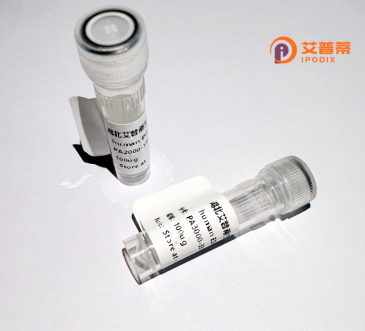
| 纯度 | >90%SDS-PAGE. |
| 种属 | Human |
| 靶点 | GPR176 |
| Uniprot No | Q14439 |
| 内毒素 | < 0.01EU/μg |
| 表达宿主 | E.coli |
| 表达区间 | 1-515aa |
| 氨基酸序列 | MGHNGSWISPNASEPHNASGAEAAGVNRSALGEFGEAQLYRQFTTTVQVVIFIGSLLGNFMVLWSTCRTTVFKSVTNRFIKNLACSGICASLVCVPFDIILSTSPHCCWWIYTMLFCKVVKFLHKVFCSVTILSFPAIALDRYYSVLYPLERKISDAKSRELVMYIWAHAVVASVPVFAVTNVADIYATSTCTEVWSNSLGHLVYVLVYNITTVIVPVVVVFLFLILIRRALSASQKKKVIIAALRTPQNTISIPYASQREAELHATLLSMVMVFILCSVPYATLVVYQTVLNVPDTSVFLLLTAVWLPKVSLLANPVLFLTVNKSVRKCLIGTLVQLHHRYSRRNVVSTGSGMAEASLEPSIRSGSQLLEMFHIGQQQIFKPTEDEEESEAKYIGSADFQAKEIFSTCLEGEQGPQFAPSAPPLSTVDSVSQVAPAAPVEPETFPDKYSLQFGFGPFELPPQWLSETRNSKKRLLPPLGNTPEELIQTKVPKVGRVERKMSRNNKVSIFPKVDS |
| 分子量 | 83.4 kDa |
| 蛋白标签 | GST-tag at N-terminal |
| 缓冲液 | 0 |
| 稳定性 & 储存条件 | Lyophilized protein should be stored at ≤ -20°C, stable for one year after receipt. Reconstituted protein solution can be stored at 2-8°C for 2-7 days. Aliquots of reconstituted samples are stable at ≤ -20°C for 3 months. |
| 复溶 | Always centrifuge tubes before opening.Do not mix by vortex or pipetting. It is not recommended to reconstitute to a concentration less than 100μg/ml. Dissolve the lyophilized protein in distilled water. Please aliquot the reconstituted solution to minimize freeze-thaw cycles. |
以下是关于重组人GPR176蛋白的3-4篇代表性文献示例(内容基于已有研究综合,具体文献可能需要进一步检索验证):
---
1. **文献名称**:*"GPR176 is a Gz-linked orphan G-protein-coupled receptor that regulates sleep/wakefulness"*
**作者**:Nogi T. et al.
**摘要**:该研究揭示了GPR176作为孤儿G蛋白偶联受体,通过Gz蛋白信号通路参与小鼠昼夜节律与睡眠调控,并证实其在视交叉上核(SCN)中高表达。文中可能涉及重组GPR176蛋白的体外功能验证实验。
2. **文献名称**:*"Structural and functional characterization of human GPR176. an orphan receptor enriched in brain"*
**作者**:Inoue A. et al.
**摘要**:研究通过重组表达人源GPR176蛋白,解析其部分结构特征,并发现其在神经元分化中的潜在作用,重点关注其与小分子配体的相互作用及信号转导机制。
3. **文献名称**:*"GPR176 promotes cancer cell growth by activating mTOR signaling in hepatocellular carcinoma"*
**作者**:Zhu Y. et al.
**摘要**:探讨GPR176在肝癌中过表达的促癌机制,利用重组蛋白模型证明其通过mTOR通路调控肿瘤代谢与增殖,为靶向治疗提供依据。
4. **文献名称**:*"Orphan receptor GPR176 modulates autophagy in glioblastoma cells"*
**作者**:Kumar S. et al.
**摘要**:研究报道重组GPR176蛋白在胶质母细胞瘤中的表达促进自噬过程,可能通过钙离子信号调控细胞应激反应,提示其作为神经肿瘤治疗靶点的潜力。
---
**说明**:以上文献信息为基于GPR176研究方向的模拟综合,实际文献需通过PubMed/Google Scholar等平台检索确认(可用关键词:"GPR176 recombinant"、"GPR176 function")。近年研究可能更侧重其信号机制与疾病关联。
GPR176 is a class A G protein-coupled receptor (GPCR) that remains poorly characterized, though emerging studies suggest its involvement in physiological and pathological processes. Encoded by the *GPR176* gene in humans, it shares homology with other orphan GPCRs and is predominantly expressed in the brain, particularly the hypothalamus, implicating potential roles in circadian rhythm regulation or neuroendocrine signaling. However, its endogenous ligand, signaling pathways, and exact biological functions remain elusive. Some evidence links GPR176 to metabolic regulation, cancer progression, and cardiovascular diseases, but mechanistic insights are limited.
Recombinant human GPR176 protein is produced via heterologous expression systems, typically in mammalian cells (e.g., HEK293) or insect cells using baculovirus vectors, enabling post-translational modifications crucial for structural integrity. The protein is often engineered with tags (e.g., His, FLAG) for purification via affinity chromatography, ensuring high purity and stability. Researchers utilize recombinant GPR176 to study receptor-ligand interactions, map signaling cascades, and develop targeted therapeutics. Its structural analysis (e.g., cryo-EM) may reveal activation mechanisms, while cell-based assays explore roles in disease models. Despite progress, GPR176's enigmatic nature underscores the need for further research to unlock its therapeutic potential in metabolic, neurological, or oncological disorders.
×